- Welcome to ST-Riders - The liST.
Recent posts
#81
ST1100 Archive of Wisdom / Converting Rear Wheel and Moun...
Last post by KoTAOW - March 01, 2012, 06:08:14 PMOriginal article can be found here: http://www.stealth11.com/CTconversion.htm
Written by Norm Kokes
~~~
Following comments by KotAOW:
Disclaimer:
The information contained in this article is for general information only. Whilst the author(s) endeavors to ensure the accuracy of this general information, no statement, representation, warranty or guarantee, express or implied, is given as to its accuracy or appropriateness for use in any particular circumstances.
The author(s) are NOT responsible for any loss or damage whatsoever arising out of or in connection with any information on this specific subject. Users are responsible for making their own assessment of all information contained in this article and are advised to verify such information.
~~~
Purpose:
This article is a collection of many threads posted on different motorcycle forums. It is NOT to be considered a "how-to or step-by-step" procedure for converting your ST1100 w\o ABS to use a Car Tire on the rear.
Also, this article shouldn't be construed as a place to debate the use of a Car Tire on a motorcycle. That subject has been thoroughly scrutinized enough elsewhere by many believers and non-believers.
Each rider must determine the advantages and dis-advantages before continuing down this path to the "Darkside."
~~~

This is the 1995 ST1100 I converted to a STealth11 reverse trike. While it has a pair of Automobile steel belted radials on the front I was stuck with a standard motorcycle tire on the rear as the ST1100 has a 17" rim and no usable car tire is available for this size rim. The fix was to remove the rear wheel and fit a Goldwing GL1500 rear rim to the bike. Honda is a smart company so most Honda parts are interchangeable between model classes. The drive spar for most shaft drive Honda motorcycle interchange. So do the brake rotors and calipers.
My goal was to find a 16" rim so I could use a 175x60 rear CT in lieu of the MC tires which are not suited well to this particular application. These tires are available for the modest price of $73 and will last 35k or more vs the 6k I could expect from a $150 MC tire.
As usual Sport Wheels in near by Shakopee MN had several candidates on hand so I picked up a GL1500rim which fit perfectly with just a couple adjustments. First as I figured the drive side fit perfect, the entire assembly is 1" narrower than the stock ST unit so I made a 1" axle spacer out of a piece of standard water pipe, with this everything dropped into place for viewing.
Here are the two wheels - ST 17" on the left and GL1500 16" on the right. As you can see the drive side is identical along with the bearings etc.
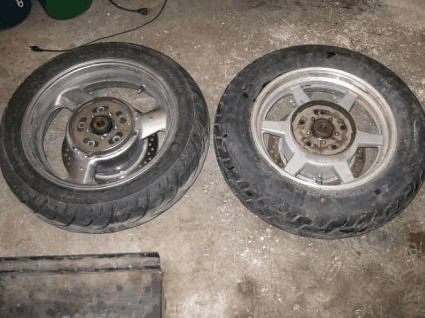
Here is the 1" spacer I made to compensate for the narrower wheel assembly - the original caliper and support bracket is also a
perfect fit along with the brake rotor.
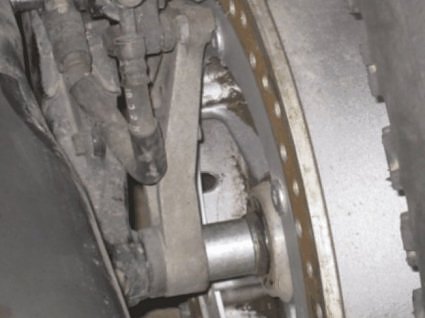
View of the GL wheel mounted. Here again the wheel fits nicely and required now modification at this point.
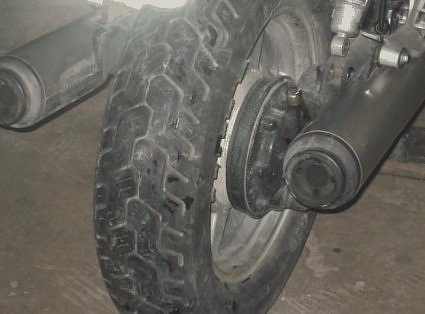
Modification for Car Tire use.
If this was a standard ST1100 and I just wished to go to a different rim I would be done however for a CT to fit in the swing arm I needed to shift the wheel slightly to the left so the new tire would clear the drive shaft tube. For this a very minor modification was needed.
First I grabbed a piece of brass I had laying around and chucked it in the lathe to create a 1/4" thick spacer.
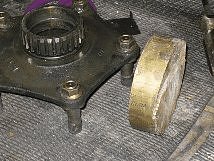
Once down to the proper diameter I also added a raised portion to compensate for the stock spacer that is part of the drive assembly.
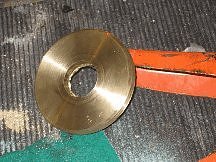
Rough spacer in place for testing - in the final setup the spacer is split as the inner part does not turn and is fixed
to the drive axle and the outer part with the drive hub rotate with the wheel.
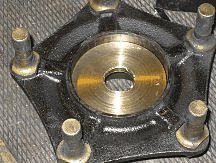
Here it is all assembled and the brass spacer has been cut into two pieces.
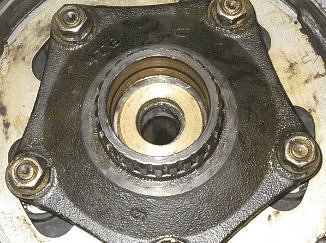
Now that the wheel has been shifted 1/4" to the left I also needed to modify the left side to allow proper alignment of the brake assembly.
The hard steel axle bushing insert was remove and the locking nub reduced by 1/4" on the milling machine.
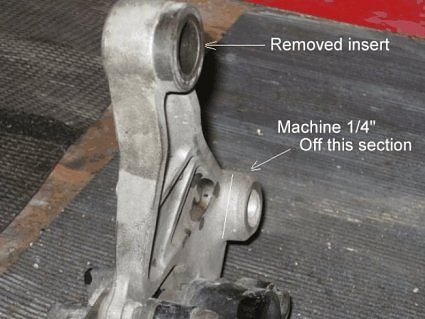
The original caliper once modified fits fine and the rotor here is the GL rotor which is identical to the ST rotor.
On the right I now have 1/2" of space between the wheel and drive shaft tube - 3/4" on the left
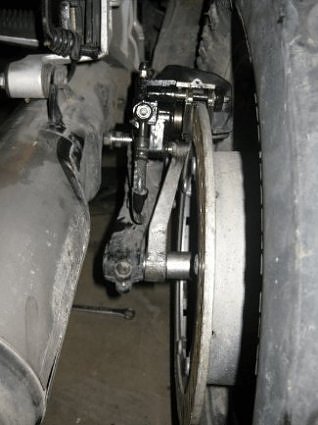
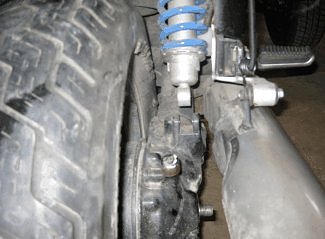
The tires showed up today - Formoza "steel" belted radial tire - non-runflat and looking good - $73 plus tax and shipping so about
1/2 the price of a MC tire bias or fabric radial. I expect 35-40K to be average life on the tires on this trike mainly due to the
low load on each wheel (approx 260lbs)
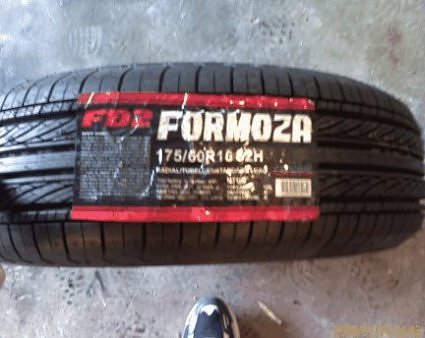
Here is the CT and OEM tire next to each other. The tires are about the same width but as you can see the CT is about
1" to 1-1/4" smaller in diameter. For this application this is good for several reasons It lowers the bike about 3/4" and
helps with the ST high gearing so take off and cruising is set to a more comfortable power band.
Also take note of the very narrow wear pattern on the MC tire - this tire is near shot and has less than 3,000 miles on it.
It would not have made 5000.
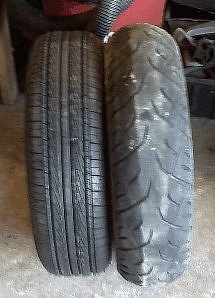
Install was a snap - some soap and a nudge with the spoons and on she went The shims and spacers worked out just perfect
as the tire clears the swingarm by the predicted 1/4" and as with most CT installs, start to finish was less than 15 minutes.
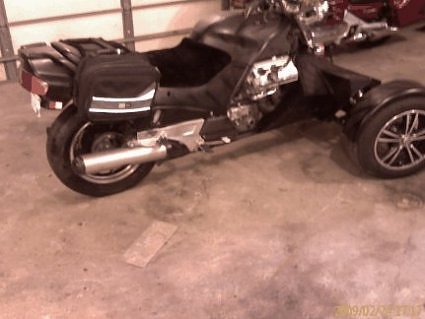
I did paint the wheel black and polished out the flanges so it fits in with the front mag wheels. Test ride was a total success as the pull away from a dead stop was better than ever and the ride was no longer harsh as with the harder MC tire - pressure on the front tires is 12.5psi and the rear is set to 25 psi - tire footprint is perfect at this rate. If this was a standard two wheeler I would use the same pressure on the rear as any higher would detract from the axle to surface geometry during cornering.
As is this project is complete and a success........
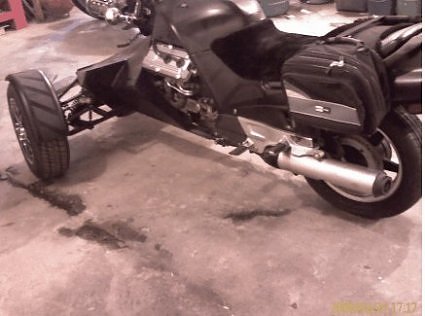
~~~
Thank You again for your contribution Norm Kokes
Written by Norm Kokes
~~~
Following comments by KotAOW:
Disclaimer:
The information contained in this article is for general information only. Whilst the author(s) endeavors to ensure the accuracy of this general information, no statement, representation, warranty or guarantee, express or implied, is given as to its accuracy or appropriateness for use in any particular circumstances.
The author(s) are NOT responsible for any loss or damage whatsoever arising out of or in connection with any information on this specific subject. Users are responsible for making their own assessment of all information contained in this article and are advised to verify such information.
~~~
Purpose:
This article is a collection of many threads posted on different motorcycle forums. It is NOT to be considered a "how-to or step-by-step" procedure for converting your ST1100 w\o ABS to use a Car Tire on the rear.
Also, this article shouldn't be construed as a place to debate the use of a Car Tire on a motorcycle. That subject has been thoroughly scrutinized enough elsewhere by many believers and non-believers.
Each rider must determine the advantages and dis-advantages before continuing down this path to the "Darkside."
~~~
Converting Rear Wheel and Mounting a Car Tire - Part 2 ( ST1100 )

This is the 1995 ST1100 I converted to a STealth11 reverse trike. While it has a pair of Automobile steel belted radials on the front I was stuck with a standard motorcycle tire on the rear as the ST1100 has a 17" rim and no usable car tire is available for this size rim. The fix was to remove the rear wheel and fit a Goldwing GL1500 rear rim to the bike. Honda is a smart company so most Honda parts are interchangeable between model classes. The drive spar for most shaft drive Honda motorcycle interchange. So do the brake rotors and calipers.
My goal was to find a 16" rim so I could use a 175x60 rear CT in lieu of the MC tires which are not suited well to this particular application. These tires are available for the modest price of $73 and will last 35k or more vs the 6k I could expect from a $150 MC tire.
As usual Sport Wheels in near by Shakopee MN had several candidates on hand so I picked up a GL1500rim which fit perfectly with just a couple adjustments. First as I figured the drive side fit perfect, the entire assembly is 1" narrower than the stock ST unit so I made a 1" axle spacer out of a piece of standard water pipe, with this everything dropped into place for viewing.
Here are the two wheels - ST 17" on the left and GL1500 16" on the right. As you can see the drive side is identical along with the bearings etc.

Here is the 1" spacer I made to compensate for the narrower wheel assembly - the original caliper and support bracket is also a
perfect fit along with the brake rotor.

View of the GL wheel mounted. Here again the wheel fits nicely and required now modification at this point.

Modification for Car Tire use.
If this was a standard ST1100 and I just wished to go to a different rim I would be done however for a CT to fit in the swing arm I needed to shift the wheel slightly to the left so the new tire would clear the drive shaft tube. For this a very minor modification was needed.
First I grabbed a piece of brass I had laying around and chucked it in the lathe to create a 1/4" thick spacer.

Once down to the proper diameter I also added a raised portion to compensate for the stock spacer that is part of the drive assembly.

Rough spacer in place for testing - in the final setup the spacer is split as the inner part does not turn and is fixed
to the drive axle and the outer part with the drive hub rotate with the wheel.

Here it is all assembled and the brass spacer has been cut into two pieces.

Now that the wheel has been shifted 1/4" to the left I also needed to modify the left side to allow proper alignment of the brake assembly.
The hard steel axle bushing insert was remove and the locking nub reduced by 1/4" on the milling machine.

The original caliper once modified fits fine and the rotor here is the GL rotor which is identical to the ST rotor.
On the right I now have 1/2" of space between the wheel and drive shaft tube - 3/4" on the left


The tires showed up today - Formoza "steel" belted radial tire - non-runflat and looking good - $73 plus tax and shipping so about
1/2 the price of a MC tire bias or fabric radial. I expect 35-40K to be average life on the tires on this trike mainly due to the
low load on each wheel (approx 260lbs)

Here is the CT and OEM tire next to each other. The tires are about the same width but as you can see the CT is about
1" to 1-1/4" smaller in diameter. For this application this is good for several reasons It lowers the bike about 3/4" and
helps with the ST high gearing so take off and cruising is set to a more comfortable power band.
Also take note of the very narrow wear pattern on the MC tire - this tire is near shot and has less than 3,000 miles on it.
It would not have made 5000.

Install was a snap - some soap and a nudge with the spoons and on she went The shims and spacers worked out just perfect
as the tire clears the swingarm by the predicted 1/4" and as with most CT installs, start to finish was less than 15 minutes.

I did paint the wheel black and polished out the flanges so it fits in with the front mag wheels. Test ride was a total success as the pull away from a dead stop was better than ever and the ride was no longer harsh as with the harder MC tire - pressure on the front tires is 12.5psi and the rear is set to 25 psi - tire footprint is perfect at this rate. If this was a standard two wheeler I would use the same pressure on the rear as any higher would detract from the axle to surface geometry during cornering.
As is this project is complete and a success........

~~~
Thank You again for your contribution Norm Kokes
#82
ST1300 Archive of Wisdom / Removing Electrical Terminals ...
Last post by KoTAOW - February 23, 2012, 03:26:48 PMSubmitted by Norm Keller, STOC #8030
Original article can be found here: http://www.my-mc.com/messages/39524/139146.html?1290836955
~~~
I frequently see examples of electrical system work in which wires are cut, stripped back & twisted, etc. in order to make connection to an existing circuit. In other cases, a terminal is making poor contact but has not been serviced in order to remove corrosion or tighten the "grip" of the connection.
Most terminals whether spade, or miniature bullet, etc. which are installed as original equipment on motorcycles or automobiles use some fairly standard configurations in which the connectors are held into a plastic plug body. In most cases these connectors can be readily removed from the plug body in order to attach an additional wire, clean or tighten the connector, or replace the connector.
Here is a photo of a large spade lug type connector which is illustrated because the large size makes the terminals easier to see:
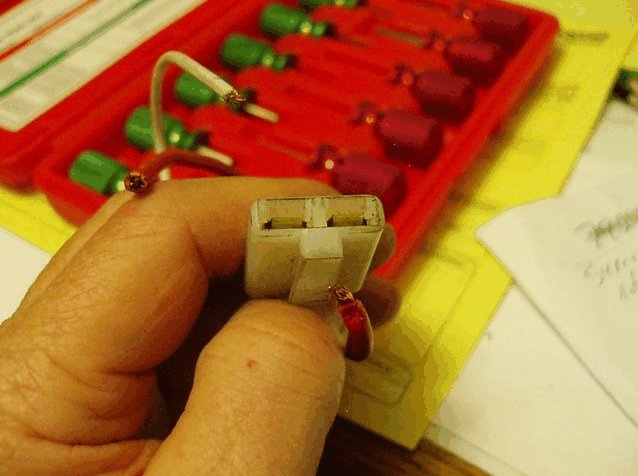
Terminal tools of various types are available to depress the locking tab on the terminal. The tool illustrated is intended to depress the flat blade terminal on flat bodied connectors. There are several widths & thickness of tools.

The terminal tool is inserted into the plug body in order to depress the locking tab. This tab is usually in the form of a blade which swings out from the terminal to engage the plug body.

Note that it is usually best to push the terminal firmly into the plug body so that the end of the locking blade comes free of the ledge in the plug body. Some plug bodys have a raised lip or pocket into which the terminal's blade fits to it is difficult to impossible to press the blade flat without damaging the blade unless the end of the blade is pushed past the lip.

In the following photo, note that the blade is being bent outward again in preparation to reinstall the terminal into the plug body. It is best not to bent the blade out further than necessary because over bending can snap the blade.

Here is a photo of the terminal from the ABS Warning Light Module plug. Note the top right terminal which is recessed as this was likely the cause of the intermittent connection which was plaguing my right hand ABS warning light.

Press the terminal out, reset the blade and reinstall.

If wishing to have another wire attached, I will remove the terminal and solder a second wire along side the first, then re-install.
The round (barrel) type connectors are released by a tubular tool which is usually inserted into the end opposite the wire. Here are some examples of the tools but I can't seem to find my supply of tubular terminals:

These slide over the tubular type terminals in order to depress the locking tab(s). I will try to remember to find and post some examples.
Another type of plug and terminal is seem below. This is a common type automotive connector of the Weatherpack and similar types. Note the red rubber sealing gasket. This uses a tubular type but the terminals are locked by means of a wedge block and a lip on the end of the plug. Note the blue colored wedge block in the end.

Here is a shot of the wedge block having been pried from the plug body:

Next is a shot of the plug with wedge block removed and one terminal extracted. In this style plug, the end of the terminal needs be deflected away from the lip on the other side of the body as can been seen obscuring an arc of the end of the other terminal. When clear of the lip, the terminal can be pushed out, usually by pushing on the wire.

There are other types but so many that is would be impractical to try to post them all.
I recommend that anyone who has not done so, look for some used wiring plugs of the types used on the ST. These are commonly available from bike wreckers as parts of damaged wiring harnesses. These are good to use for practise. My thread entitled: "Headlight Ground Circuit Modification" describes soldering wires to the spade lug type terminal.
~~~
Thank You again for your contribution Norm Keller, STOC #8030
Original article can be found here: http://www.my-mc.com/messages/39524/139146.html?1290836955
~~~
Removing Electrical Terminals ( ST1100\ST1300 )
I frequently see examples of electrical system work in which wires are cut, stripped back & twisted, etc. in order to make connection to an existing circuit. In other cases, a terminal is making poor contact but has not been serviced in order to remove corrosion or tighten the "grip" of the connection.
Most terminals whether spade, or miniature bullet, etc. which are installed as original equipment on motorcycles or automobiles use some fairly standard configurations in which the connectors are held into a plastic plug body. In most cases these connectors can be readily removed from the plug body in order to attach an additional wire, clean or tighten the connector, or replace the connector.
Here is a photo of a large spade lug type connector which is illustrated because the large size makes the terminals easier to see:

Terminal tools of various types are available to depress the locking tab on the terminal. The tool illustrated is intended to depress the flat blade terminal on flat bodied connectors. There are several widths & thickness of tools.

The terminal tool is inserted into the plug body in order to depress the locking tab. This tab is usually in the form of a blade which swings out from the terminal to engage the plug body.

Note that it is usually best to push the terminal firmly into the plug body so that the end of the locking blade comes free of the ledge in the plug body. Some plug bodys have a raised lip or pocket into which the terminal's blade fits to it is difficult to impossible to press the blade flat without damaging the blade unless the end of the blade is pushed past the lip.

In the following photo, note that the blade is being bent outward again in preparation to reinstall the terminal into the plug body. It is best not to bent the blade out further than necessary because over bending can snap the blade.

Here is a photo of the terminal from the ABS Warning Light Module plug. Note the top right terminal which is recessed as this was likely the cause of the intermittent connection which was plaguing my right hand ABS warning light.

Press the terminal out, reset the blade and reinstall.

If wishing to have another wire attached, I will remove the terminal and solder a second wire along side the first, then re-install.
The round (barrel) type connectors are released by a tubular tool which is usually inserted into the end opposite the wire. Here are some examples of the tools but I can't seem to find my supply of tubular terminals:

These slide over the tubular type terminals in order to depress the locking tab(s). I will try to remember to find and post some examples.
Another type of plug and terminal is seem below. This is a common type automotive connector of the Weatherpack and similar types. Note the red rubber sealing gasket. This uses a tubular type but the terminals are locked by means of a wedge block and a lip on the end of the plug. Note the blue colored wedge block in the end.

Here is a shot of the wedge block having been pried from the plug body:

Next is a shot of the plug with wedge block removed and one terminal extracted. In this style plug, the end of the terminal needs be deflected away from the lip on the other side of the body as can been seen obscuring an arc of the end of the other terminal. When clear of the lip, the terminal can be pushed out, usually by pushing on the wire.

There are other types but so many that is would be impractical to try to post them all.
I recommend that anyone who has not done so, look for some used wiring plugs of the types used on the ST. These are commonly available from bike wreckers as parts of damaged wiring harnesses. These are good to use for practise. My thread entitled: "Headlight Ground Circuit Modification" describes soldering wires to the spade lug type terminal.
~~~
Thank You again for your contribution Norm Keller, STOC #8030
#83
ST1100 Archive of Wisdom / Removing Electrical Terminals ...
Last post by KoTAOW - February 23, 2012, 08:59:30 AMSubmitted by Norm Keller, STOC #8030
Original article can be found here: http://www.my-mc.com/messages/39524/139146.html?1290836955
~~~
I frequently see examples of electrical system work in which wires are cut, stripped back & twisted, etc. in order to make connection to an existing circuit. In other cases, a terminal is making poor contact but has not been serviced in order to remove corrosion or tighten the "grip" of the connection.
Most terminals whether spade, or miniature bullet, etc. which are installed as original equipment on motorcycles or automobiles use some fairly standard configurations in which the connectors are held into a plastic plug body. In most cases these connectors can be readily removed from the plug body in order to attach an additional wire, clean or tighten the connector, or replace the connector.
Here is a photo of a large spade lug type connector which is illustrated because the large size makes the terminals easier to see:

Terminal tools of various types are available to depress the locking tab on the terminal. The tool illustrated is intended to depress the flat blade terminal on flat bodied connectors. There are several widths & thickness of tools.

The terminal tool is inserted into the plug body in order to depress the locking tab. This tab is usually in the form of a blade which swings out from the terminal to engage the plug body.

Note that it is usually best to push the terminal firmly into the plug body so that the end of the locking blade comes free of the ledge in the plug body. Some plug bodys have a raised lip or pocket into which the terminal's blade fits to it is difficult to impossible to press the blade flat without damaging the blade unless the end of the blade is pushed past the lip.

In the following photo, note that the blade is being bent outward again in preparation to reinstall the terminal into the plug body. It is best not to bent the blade out further than necessary because over bending can snap the blade.

Here is a photo of the terminal from the ABS Warning Light Module plug. Note the top right terminal which is recessed as this was likely the cause of the intermittent connection which was plaguing my right hand ABS warning light.

Press the terminal out, reset the blade and reinstall.

If wishing to have another wire attached, I will remove the terminal and solder a second wire along side the first, then re-install.
The round (barrel) type connectors are released by a tubular tool which is usually inserted into the end opposite the wire. Here are some examples of the tools but I can't seem to find my supply of tubular terminals:

These slide over the tubular type terminals in order to depress the locking tab(s). I will try to remember to find and post some examples.
Another type of plug and terminal is seem below. This is a common type automotive connector of the Weatherpack and similar types. Note the red rubber sealing gasket. This uses a tubular type but the terminals are locked by means of a wedge block and a lip on the end of the plug. Note the blue colored wedge block in the end.

Here is a shot of the wedge block having been pried from the plug body:

Next is a shot of the plug with wedge block removed and one terminal extracted. In this style plug, the end of the terminal needs be deflected away from the lip on the other side of the body as can been seen obscuring an arc of the end of the other terminal. When clear of the lip, the terminal can be pushed out, usually by pushing on the wire.

There are other types but so many that is would be impractical to try to post them all.
I recommend that anyone who has not done so, look for some used wiring plugs of the types used on the ST. These are commonly available from bike wreckers as parts of damaged wiring harnesses. These are good to use for practise. My thread entitled: "Headlight Ground Circuit Modification" describes soldering wires to the spade lug type terminal.
~~~
Thank You again for your contribution Norm Keller, STOC #8030
Original article can be found here: http://www.my-mc.com/messages/39524/139146.html?1290836955
~~~
Removing Electrical Terminals ( ST1100\ST1300 )
I frequently see examples of electrical system work in which wires are cut, stripped back & twisted, etc. in order to make connection to an existing circuit. In other cases, a terminal is making poor contact but has not been serviced in order to remove corrosion or tighten the "grip" of the connection.
Most terminals whether spade, or miniature bullet, etc. which are installed as original equipment on motorcycles or automobiles use some fairly standard configurations in which the connectors are held into a plastic plug body. In most cases these connectors can be readily removed from the plug body in order to attach an additional wire, clean or tighten the connector, or replace the connector.
Here is a photo of a large spade lug type connector which is illustrated because the large size makes the terminals easier to see:

Terminal tools of various types are available to depress the locking tab on the terminal. The tool illustrated is intended to depress the flat blade terminal on flat bodied connectors. There are several widths & thickness of tools.

The terminal tool is inserted into the plug body in order to depress the locking tab. This tab is usually in the form of a blade which swings out from the terminal to engage the plug body.

Note that it is usually best to push the terminal firmly into the plug body so that the end of the locking blade comes free of the ledge in the plug body. Some plug bodys have a raised lip or pocket into which the terminal's blade fits to it is difficult to impossible to press the blade flat without damaging the blade unless the end of the blade is pushed past the lip.

In the following photo, note that the blade is being bent outward again in preparation to reinstall the terminal into the plug body. It is best not to bent the blade out further than necessary because over bending can snap the blade.

Here is a photo of the terminal from the ABS Warning Light Module plug. Note the top right terminal which is recessed as this was likely the cause of the intermittent connection which was plaguing my right hand ABS warning light.

Press the terminal out, reset the blade and reinstall.

If wishing to have another wire attached, I will remove the terminal and solder a second wire along side the first, then re-install.
The round (barrel) type connectors are released by a tubular tool which is usually inserted into the end opposite the wire. Here are some examples of the tools but I can't seem to find my supply of tubular terminals:

These slide over the tubular type terminals in order to depress the locking tab(s). I will try to remember to find and post some examples.
Another type of plug and terminal is seem below. This is a common type automotive connector of the Weatherpack and similar types. Note the red rubber sealing gasket. This uses a tubular type but the terminals are locked by means of a wedge block and a lip on the end of the plug. Note the blue colored wedge block in the end.

Here is a shot of the wedge block having been pried from the plug body:

Next is a shot of the plug with wedge block removed and one terminal extracted. In this style plug, the end of the terminal needs be deflected away from the lip on the other side of the body as can been seen obscuring an arc of the end of the other terminal. When clear of the lip, the terminal can be pushed out, usually by pushing on the wire.

There are other types but so many that is would be impractical to try to post them all.
I recommend that anyone who has not done so, look for some used wiring plugs of the types used on the ST. These are commonly available from bike wreckers as parts of damaged wiring harnesses. These are good to use for practise. My thread entitled: "Headlight Ground Circuit Modification" describes soldering wires to the spade lug type terminal.
~~~
Thank You again for your contribution Norm Keller, STOC #8030
#84
ST1100 Archive of Wisdom / Adjustable Windshield ( ST1100...
Last post by KoTAOW - February 20, 2012, 03:24:10 PMSubmitted by Bob Meyer, STOC #1157
Original article can be found here: http://www.st-riders.net/index.php?topic=1997.0
~~~
Side view, shield down.

Side view, shield up.
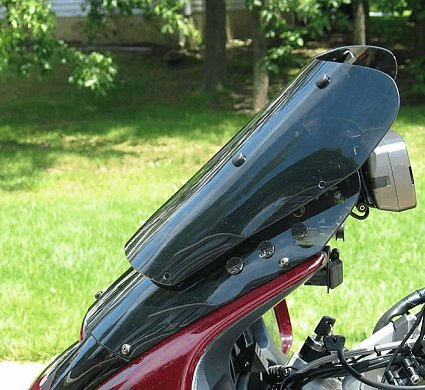
Rear view, shield down.
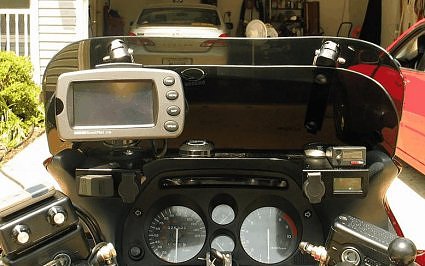
Rear view, shield up.
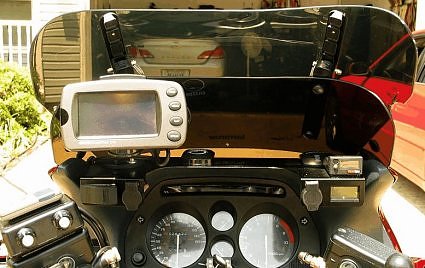
Front view, shield down.
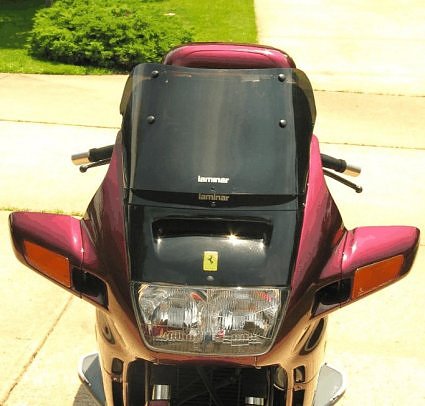
Front view, shield up.
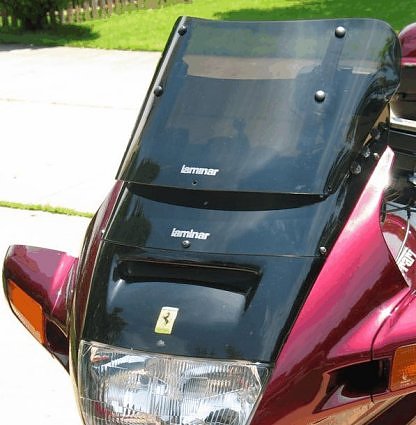
~~~
Here's some more detail:
This is built on the Laminar Cafe shield. I really like the Laminar Cafe in the summer, but when it rains I'd like something taller. And even with the lip, the air coming over it is pretty noisy, although the lip keeps it smooth, without much buffeting.
Laminar Products for ST1100
I happen to have two Laminar Cafe shields. The first one I received was molded incorrectly, and cracked at one of the side mounting holes. Laminar replaced it, of course, but I hung on to the old one with a mind toward making an adjustable shield someday, somehow.
When Tim Shevlin, STOC #1183 made his adjustable sliders for the Laminar Lip itself, I tried adapting that to make an adjustable shield, but it just didn't work. I didn't have a lot of confidence the metal sliders were strong enough to support a complete windshield, rather than just the lip, and I didn't feel real good about have several pieces of relatively sharp-edged metal right in front of me.
But there was another, similar mechanism designed specifically for adjustable windshields: Firecreek Accessories, LLc.
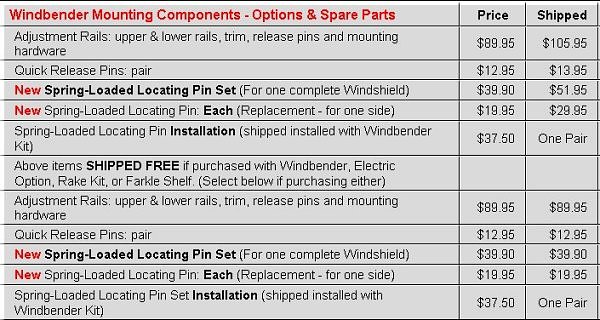
Tom Yeager at Firecreek Accessories, LLc. has been making his Windbender adjustable shields for Goldwings for years, and actually made a prototype shield for the 1100: http://www.my-mc.com/messages/1/15978.html
But abandoned it when the 1300 came out with a factory electric shield. I actually had the opportunity to ride with the owner of that prototype many years ago, and after I ended up with my two cafe shields I contacted Tom and asked if he would sell me the hardware only. At that time, he said no. But this past fall, I decide to try again, and this time he said "yes"!! I paid $38.50 + shipping for all the hardware. The sliders are made of a nylon-like material, and have naturally low friction. The fixed piece is undercut, and the moveable piece slides up and down in the undercut groove. The moveable piece, in turn, has 4 cross slots cut in it, at one inch intervals, giving a total adjustment range of 3 inches. There's a hole cut sideways through the top of each of the fixed pieces--line up one of the slots in the slider with the hole, and insert a pin to hold the two parts together. Can't be done while riding, of course, but it only takes about 30 seconds to make the change.
It took me a while to get around to it, but this weekend I finally took my cafe shields, took a bunch of measurements, made some templates, drilled some holes, and put the whole thing together. I was a bit concerned that 3" wouldn't really be enough, but while I would like more adjustment 3" is actually pretty significant.
I took some test rides this morning: With just the bottom laminar shield (and no lip), I got what I expected. Lots of wind, but also lots of buffeting, and lots of noise, especially at the helmet's top vents. No way I'd want to ride very far that way.
I added the top shield, in the full low position. What an amazing transformation! The gap between the two shields acts like a laminar lip on steroids. I still got lots of cooing air on my upper body and face (with the visor flipped up), but it was much smoother and quieter. If I pushed up on my feet, to get my head higher, I could get back into the noise. I'd estimate the second shield pushed the clean air up about 2 inches above the top of my helmet.
With the shield raised to it's highest position, it blocks most of the wind off my body, and leaves a bit of wind on my face, but at a much lower velocity than in the low position. And it's at least as smooth and quiet as my laminar combo shield while being lower overall. (I didn't do a back to back comparison, but I've been riding with the laminar combo all spring.) I'm really kind of surprised how well it works. I was planning to add the lip to the top shield, and maybe I'll experiment, but right now I don't think I'll need it.
I did make one mistake: I measured and drilled the shields with them off the bike. Mounting the fixed shield to the bike flexes the plastic, changing the shape a little bit. The two shields don't fit together quite as smoothly as they did before mounting, but the material of the sliders is slippery enough they are still easy to adjust.
Now I don't envy the adjustable shield on the 1300 quite as much. I could even make it electrically adjustable if I wanted it bad enough, but at $575 for the electric adjuster I think I'll pass.
Edit: The profile of the lower part of the laminar combo shield is the same shape as the bottom of the laminar cafe. I think I'm going to buy another set of the moveable part of the slider and add it to the Laminar combo for fall and winter riding.
~~~
Thank You again for your contribution Bob Meyer, STOC #1157
Original article can be found here: http://www.st-riders.net/index.php?topic=1997.0
~~~
Adjustable Windshield ( ST1100 )
Side view, shield down.

Side view, shield up.

Rear view, shield down.

Rear view, shield up.

Front view, shield down.

Front view, shield up.

~~~
Here's some more detail:
This is built on the Laminar Cafe shield. I really like the Laminar Cafe in the summer, but when it rains I'd like something taller. And even with the lip, the air coming over it is pretty noisy, although the lip keeps it smooth, without much buffeting.
Laminar Products for ST1100
I happen to have two Laminar Cafe shields. The first one I received was molded incorrectly, and cracked at one of the side mounting holes. Laminar replaced it, of course, but I hung on to the old one with a mind toward making an adjustable shield someday, somehow.
When Tim Shevlin, STOC #1183 made his adjustable sliders for the Laminar Lip itself, I tried adapting that to make an adjustable shield, but it just didn't work. I didn't have a lot of confidence the metal sliders were strong enough to support a complete windshield, rather than just the lip, and I didn't feel real good about have several pieces of relatively sharp-edged metal right in front of me.
But there was another, similar mechanism designed specifically for adjustable windshields: Firecreek Accessories, LLc.

Tom Yeager at Firecreek Accessories, LLc. has been making his Windbender adjustable shields for Goldwings for years, and actually made a prototype shield for the 1100: http://www.my-mc.com/messages/1/15978.html
But abandoned it when the 1300 came out with a factory electric shield. I actually had the opportunity to ride with the owner of that prototype many years ago, and after I ended up with my two cafe shields I contacted Tom and asked if he would sell me the hardware only. At that time, he said no. But this past fall, I decide to try again, and this time he said "yes"!! I paid $38.50 + shipping for all the hardware. The sliders are made of a nylon-like material, and have naturally low friction. The fixed piece is undercut, and the moveable piece slides up and down in the undercut groove. The moveable piece, in turn, has 4 cross slots cut in it, at one inch intervals, giving a total adjustment range of 3 inches. There's a hole cut sideways through the top of each of the fixed pieces--line up one of the slots in the slider with the hole, and insert a pin to hold the two parts together. Can't be done while riding, of course, but it only takes about 30 seconds to make the change.
It took me a while to get around to it, but this weekend I finally took my cafe shields, took a bunch of measurements, made some templates, drilled some holes, and put the whole thing together. I was a bit concerned that 3" wouldn't really be enough, but while I would like more adjustment 3" is actually pretty significant.
I took some test rides this morning: With just the bottom laminar shield (and no lip), I got what I expected. Lots of wind, but also lots of buffeting, and lots of noise, especially at the helmet's top vents. No way I'd want to ride very far that way.
I added the top shield, in the full low position. What an amazing transformation! The gap between the two shields acts like a laminar lip on steroids. I still got lots of cooing air on my upper body and face (with the visor flipped up), but it was much smoother and quieter. If I pushed up on my feet, to get my head higher, I could get back into the noise. I'd estimate the second shield pushed the clean air up about 2 inches above the top of my helmet.
With the shield raised to it's highest position, it blocks most of the wind off my body, and leaves a bit of wind on my face, but at a much lower velocity than in the low position. And it's at least as smooth and quiet as my laminar combo shield while being lower overall. (I didn't do a back to back comparison, but I've been riding with the laminar combo all spring.) I'm really kind of surprised how well it works. I was planning to add the lip to the top shield, and maybe I'll experiment, but right now I don't think I'll need it.
I did make one mistake: I measured and drilled the shields with them off the bike. Mounting the fixed shield to the bike flexes the plastic, changing the shape a little bit. The two shields don't fit together quite as smoothly as they did before mounting, but the material of the sliders is slippery enough they are still easy to adjust.
Now I don't envy the adjustable shield on the 1300 quite as much. I could even make it electrically adjustable if I wanted it bad enough, but at $575 for the electric adjuster I think I'll pass.
Edit: The profile of the lower part of the laminar combo shield is the same shape as the bottom of the laminar cafe. I think I'm going to buy another set of the moveable part of the slider and add it to the Laminar combo for fall and winter riding.
~~~
Thank You again for your contribution Bob Meyer, STOC #1157
#85
ST1100 Archive of Wisdom / Re: ABS 1 - Modulator Assembly...
Last post by KoTAOW - February 17, 2012, 09:38:40 PMABS 1 - Modulator Assembly Tutorial ( ST1100 ) - Part #10
This is a response, dated February 2012 by Norm Keller, STOC #8030, in regards to whether he repairs ABS Modulators:
Yes, I seem to be the only one in the world doing ABS modulator repairs.
I get them in from Canada, US, and Europe but no Asia, Oz or Kiwi yet so maybe they're finding a source for service? I'd be surprised to find that there isn't an Ozzie or Kiwi fixing almost anything on the planet because they are the original innovators. Simply amazing some of the stuff they do and adapt.
ST1100 ABS1 modulators are the most common one through the shop but that may be simply because of more exposure on the Honda web groups. I did an ABS2 a while ago but they seem to be a very robust design having been made for almost twice as long. Perhaps there are few showing up for service because they are much newer also? I regret not keeping track of the year of the bike and area from which they come. That might have been interesting in the long term. UK ships most of them but no idea of the relative numbers of ABS1 bikes versus this side of the pond or whether there is any effect from the apparent higher humidity there.
In case anyone asks, no the ABS2 can not be substituted for the ABS1 modulator. The operating strategy is completely different so the ECU is not compatible between the two types. If memory serves, the wiring harness is different also so a change over would be a monumental task.
I've given up trying to help people to do their own by email because it's just too difficult to try to explain ourselves back and forth. There are no parts available for these things other than some "O" rings and seals which I have been able to source through some hydraulics specialist contacts. Some things have to be machined so a labor of love too.l
It certainly isn't a money maker. Far too much work, then customs, packing and running around with the packages. The up side is that they're fairly light unlike an alternator although those are worth doing compared to sourcing a complete new one through Honda. It was fun figuring out a means to drive the 40 amp alternator for test purposes but got that worked out. Have also done some electric fuel pumps for various bikes with good success, especially given the new price. The UK people should have a source for servicing as someone on one of the groups found a small alternator shop which repairs his 40 amp. with no problems. Shipping one here and back would cost at least as much as a new alternator.
I charge $75.00 per modulator plus shipping if anyone needs one done. So far 100% success but will stop doing them if there is a failure. Worrying about whether someone is unhappy would take the motivation out of the thing.
~~~
Thank You for your contribution, Norm Keller, STOC #8030.
#86
ST1100 Archive of Wisdom / Re: ABS 1 - Modulator Assembly...
Last post by KoTAOW - February 17, 2012, 09:37:58 PMABS 1 - Modulator Assembly Tutorial ( ST1100 ) - Part #9
Comments by Jan Zuercher, STOC #5671:
Norm, Mike and others thanks for helping take some of the mystery out of the ABS system and giving others like me the courage to work on it.
I own a 1993 ST1100A bike with 55000 miles on it. The ABS has not worked since Day one and I am the third owner. I really would like to have the ABS work for safety reasons but have had no success to date in getting it to work. The TCS system works great and activated once when I was on wet grass on a hill and probably keep me from going down.
I always get the ABS trouble Code 1. I have run all the checks in the Honda manual decision tree starting on page 16A-9 and I get to the very end and it says I have a Faulty ECU. I purchased and tried a "new" ECU off ebay and it did not fix the problem. It looked used and I could only assume at the time that it was bad. All of the ABS fuses are good and I have cleaned all of the ECU connectors with contact cleaner.
With the information in this post, I decided to run some additional tests. Maybe my limit switches simply needed adjusting. Using my ohmmeter I located the front and rear limit switch wiring connectors and determined neither of them close during the ABS self test at startup. I can hear the pump motors spin and the solenoids clatter on both modulators. I used a mechanics stethoscope to confirm. The pump motor spins for about 5 seconds then the sound drops to a low frequency pulsing sound. Then the solenoids clatter. Since both are bad maybe the ECU is bad. But it is too expensive to replace! Or maybe the limit switches do need adjustment.
I went ahead and carefully pried up the rear plastic cap since I can easily get to it. I couldn't get the cap off completely due to interference with the frame. But I could get it up high enough to get a look at the insides. The contacts appear to be fine and close when I lift up on the limit switch plate with a pocket screwdriver. I watched the diaphragm bellows and it does not move at all during the ABS self-test at startup. I was hoping a simple adjustment of the limit switch position would be the fix but that is not the case.
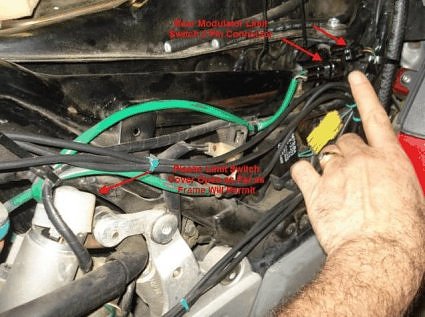
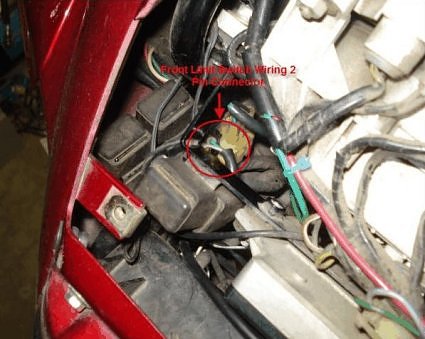
I decided to make some jumpers to see if I could fool the ECU into thinking the limit switches were working. I cleared the ABS trouble codes then started the bike. With the two wire limit switch connector for the front modulator disconnected I jumped the front limit switch circuit closed during the self test and shutdown the bike. The ABS trouble code changed! It now showed the rear modulator was bad - Code 2. Apparently, the ECU gives priority to the front modulator. If both front and rear units are not working, the ECU shows the front is bad and stores a trouble Code 1. By fooling the ECU that the front modulator was good then it stored the Code saying the rear is bad.
I then cleared the ABS trouble codes again. I then had my daughter assist me by having her jump the rear limit switch while I simultaneously jumped the front limit switch. More progress! Now I get only error Code 3.
After re-reading Norm's and Mike's postings I am now suspecting my ECU may not be bad and that what I really have are two stuck plunger pistons. With the age of my bike and the fact that I hear the pumps spinning and the solenoids clattering it seems plausible. I still can't be sure if the ECU is bad.
The front limit switch 2 wire connector is barely accessible if you remove the windshield and instrument panel. It is located next to the relays. If you look up the wire colors from the wiring diagram you can easily spot the connector. It also looks the same as the rear one. On my 1993 bike the wires are gray with a red stripe and green with a white stripe which appears to match the wiring diagram.
The point of this is you should be able to test your front limit switch and pump are working without removing all of the Tupperware. The rear limit switch connector is easily accessed under the right side cover for testing.
FWIW - I have not manually tested the solenoids. Norm said "When operating the pump without cycling the inlet or outlet valves, the pump will fill the back-up piston cavity, compressing the spring and extending the limit switch stud". I interpret this as saying that the pump should make the diaphragm move without having to actuate the solenoids manually. My observations indicate the ECU runs the pump first during the ABS self test at startup so I should see the diaphragm move before the ECU makes the solenoids start clattering.
I have reached a dead end.
Q#1 Does anyone have ideas on what other tests I can run to pin point if the problem is the ECU or the modulators or something else?
Q#2 Is my next step to remove the front and rear modulators to check for stuck pistons?
Q#3 Are my statements in the last paragraph correct?
Thanks in advance for any help on this!
Reply by Norm Keller, STOC #8030:
The push button in the bellows which operates the limit switch moves very little so that a tool placed against the button will be more reliable indicator of movement by the back-up piston than will a visual inspection. It sounds as though you have two stuck pump piston plungers which can, hopefully, be freed up in the same way as was Mike's.
Your additional work has increased understanding of this system further because we now know that ECU preference is given to a front fault.
I think that you will need to disassemble, dump the old fluid and free the pump plungers, refill & bleed. With care, there is really no downside to checking to see if the pump plunger is stuck in one modulator.
Check back in my posts and you will see that the pump plunger cavity cap can be removed by pushing the cap inward far enough to hook the wire snap-ring out of its groove with the help of a small "O" ring pick or dental pick. The pump spool assembly can be forced outward through the cap's end of the hole by pushing from the pump drive end of the spool.
In order to gain access, as will be seen from the photos, remove the pump drive motor and drive assembly. The end of the pump plunger (piston) is the mushroom end which normally contacts the eccentric bearing of the pump drive. A hooked pry tool may be sufficient however a curved punch and 4 oz hammer will likely be required to move the spool assembly upward. Once it begins to move, it can be pushed outward through the cap's end of the bore.
Note that the spool must be able to reciprocate relatively freely in the bore because the movement of the spool against the coil springs in order to limit hydraulic pressure in the modulator. I replaced the spool's "O" rings when servicing Mike's modulator because of their age.
The plunger may be difficult to extract from the spool and, obviously, huge care must be taken so as not to damage any parts since they are not obtainable.
I used an injector puller but it may be possible to use another small puller or two prying tools at 180 degrees. The spool can be held between two soft wood blocks within a vise or clamp to allow force to be applied. The plunger is steel and quite robust.
I recommend working on the rear modulator first because it is easier to re & re.
Please keep us posted as to progress. If you would like to ship them here, I would be pleased to service them as I am interested in learning further about these modulators.
HIH
~~~
Oops, not thinking! My suggestion was backward as I was thinking of disassembly rather than of efficient checking for the presence of a stuck piston plunger.
Remove the pump motor and drive. The plunger can be inspected to see if it is free in the pump spool by viewing through the pump drive cavity. The plunger should be easily pried (or more properly pushed) out of the spool toward the pump cavity. Review of the photos will show the relationship of the plunger, spring and spool. It will be seen that the plunger should move beyond contact with it's coil spring with almost no effort/force. Moving inward may require effort if the pump plunger intakes fluid but this should not occur until near the bottom of the stroke and should be evident.
Remove the pump motor and drive and you will have the answer as to whether the pump plunger is stuck. If not, other possibilities will need to be eliminated.
If the plunger is stuck then remove the cap and shift the spool assembly to allow the plunger to be accessible as in the previous post.
Let's see whether the plunger is at fault before opening that can of worms.
Your statements in the last paragraph are correct. When the solenoid valves are not energized, the passage through the first solenoid is open to both the expander piston and back-up piston. The second solenoid valve closes the passage from the pump outlet to the pump inlet.
If the first solenoid valve is energized (with pump running) the passage to the expander piston is closed but the back-up piston will still open to pump pressure so the piston will be forced back to operate the limit switch. It does not matter whether the first solenoid is operated.
When the second solenoid valve is operated, the passage from the pump outlet and back-up piston is opened through a check valve to the pump inlet which "dumps" the pressure from the back-up piston.
When testing the pump action, activate the pump and check to see that the back-up piston activates the limit switch or moves the bellows.
Activate the second solenoid valve and ensure that the bellows returns inward. Cycle the pump and solenoid valve a few times to ensure that the back-up piston is moving in and out.
If the back-up piston is moving in and out as reflected by bellows movement, you are good to go.
The back-up piston's action can be better understood if it is referred to by a more accurate term of "accumulator piston" or accumulator. I am sure that a web search for the operation of hydraulic accumulators (spring loaded piston type) will provide any explanation required. If not, ask & I will try to explain.
~~~
Thank You again for all contributions, Norm Keller, STOC #8030 and Jan Zuercher, STOC #5671.
#87
ST1100 Archive of Wisdom / Re: ABS 1 - Modulator Assembly...
Last post by KoTAOW - February 17, 2012, 09:37:01 PMABS 1 - Modulator Assembly Tutorial ( ST1100 ) - Part #8
Service Manual: http://www.sharetheexperience.co.uk/ST1100/
Additional comments by Norm Keller, STOC #8030:
Mike Fisher beat me to the tech reference. Check page 23-7 for example. Mike labelled three cavities as "A", "B", and "C" during our discussions and that made it easier to reference fluid flows.
From Honda Service Manual:
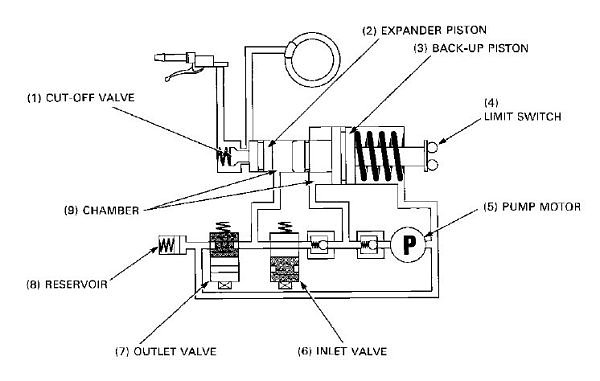
Drawings by Mike Fisher, STOC #2490:

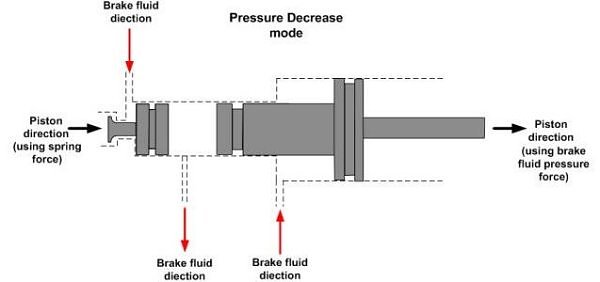
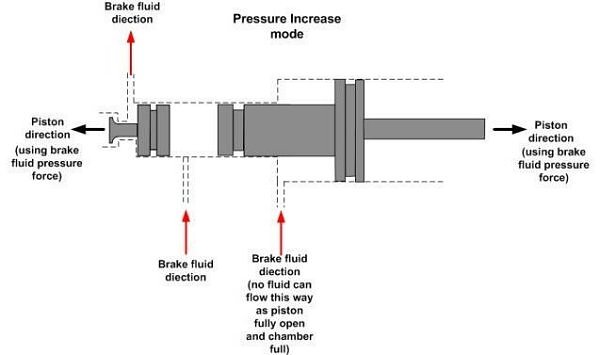
Cavity "A" is the area around the Cut-off Valve and which is open between the master cylinder (high up left in the drawing) and the brake caliper (high up, center in the drawing).
Cavity "B" is the area around the Expander Piston with the label placed directly in the centre of the piston & directly above the left hand arrow of the pair emanating from the label "(9) CHAMBER".
Cavity "C" is the area to the left of the Back-up Piston and above the fluid passage leading from the upward fluid passage to the left of the pump.
Anyone interested in understanding this system more fully may wish to label some additional parts such as the Master Cylinder, Brake Caliper and the two one-way check valves which are the devices directly to the left of the Pump.
One Check Valve is directly adjacent to the pump and is physically located in the Pump Spool. The other Check Valve is located in a passage within the modulator body as can be seen in one of the photos posted as part of the bleeding procedure.
The purpose of the first Check Valve (right hand one, closest to the Pump) is to prevent fluid flow backward into the Pump. The diagrams in the manuals seem to illustrate a rotary Pump which was misleading to those of us trying to diagnose failure causes without having disassembled the Pump. This Check Valve is responsible for maintaining pressure in the Back-up Piston chamber against the efforts of the Back-up Piston and Back-up Piston Spring. Without this check Valve, fluid would drain backward through the Pump when ever the pump was not operating.
This Check Valve is also responsible for allowing the Pump Plunger to force fluid out of the Pump, while preventing that fluid from returning into the Plunger Cavity during the intake stroke of the Pump. If that Check Valve were to fail in some manner due to debris, corrosion, etc. the Pump would not function effectively or at all. In this event the Back-up Piston would not be pushed against the Back-up Piston Spring, filling the Chamber and extending the Limit Switch Button in the Bellows.
For the purpose of testing the Pump and Back-up Piston movement, this Check Valve must function.
The Inlet Valve (solenoid valve labelled "(6)" is a normally open valve which is to say that it has an open passage (allows flow) when it is not operated by power. Applying power shuts this valve and closes the passage between Chambers "B" & "C".
For the purpose of testing the Pump and Back-up Piston movement, this solenoid valve is not energized.
The left hand Check Valve also controls fluid flow between Chambers "B" & "C" but in only one direction. This Check Valve prevents fluid flow from Chamber "B" from returning into Chamber "C" between Pump cycles because the smaller Expander Piston is also acted on by the Back-up Piston Spring which will thus create higher pressure in the Expander Piston Cavity. Were this Check Valve not present or holding, the Expander Piston fluid would tend to vent back into the Back-up Piston cavity. In the event of a fault with this Check Valve, the Pump would still succeed in filling the Expander Piston Chamber to operate the Limit Switch.
The Outlet Valve (solenoid valve labelled "(7)") is a normally closed valve which requires power in order to open the fluid flow passage. This Valve must be operated during Pump and Back-up Piston testing to see that the Back-up Piston returns to battery, allowing the Limit Switch Button in the Bellows to relax. During testing of the Pump & Back-up Piston, the Pump is energized and the Outlet Valve is operated on and off to see that the Limit Switch Button and Bellows are moving outward and inward as should be.
The diagrams in the manual are a mixed blessing because they are as misleading as they are illuminating. The only components which resemble the drawing are the Cut-off Valve, Expander Piston, and Expander Piston with Spring. The Limit Switch and other components could never be recognized as represented.
The two solenoid valves are not physically separate, but are back-to back in the solenoid pack and cannot be separated. The Check Valves are a ball and spring in the case of the left one but disk type in the case of the right (pump outlet check valve).
Mike, I recall that we discussed the possibility of loss of fluid so it is interesting that you were able to try adding fluid to the other modulator. It sounds as though it has a functioning pump although possibly the Pump Plunger is sticking partially. I would think that it should free itself were this the case as operating should scrape away deposits and small corrosion.
I am wondering if you were to exercise the modulator on some muddy ground that the fluid movement might clear the problem?
If you can energize the Pump and Solenoids on the bike, it might be interesting to monitor the Bellows to see whether it is pumping out completely or only part way during some Pump operations. It would also be interesting to energize the Inlet (solenoid) Valve during some Pump cycles to see it the Bellows holds in the full position. If the Bellows (Expander Piston) stays out with the Inlet Valve energized but not without, then it is likely that the left hand check valve is not holding.
I appreciate your correcting my suggestion to attempt the rear modulator first as I had not considered corrosion to be a factor. The modulators I have seen on Canadian/US bikes are quite corrosion free and look the same, front & rear.
This is another illustration of the effectiveness of being "hands on" and on location.
If the pressure is leaking down from the accumulator (Expander Piston), a possible cause and likely one would be that the Expander Piston seal is either worn or built up with hardened brake fluid/corrosion.
Note the rectangular rubber rings on the (smaller) Expander Piston and (larger) Back-up Piston. These may be obtainable from a speciality brake parts supplier or hydraulics supplier.
It is not unlikely that "crud" has build up on and beneath the Expander Piston Seal which is allowing fluid to channel past the seal. It would be worth checking during servicing.
Another possibility which comes to mind is that the low fluid level has allowed air to mix with the fluid in the modulator which would affect the Pump's ability to build pressure. Did you notice the fluid color? Was it clear/translucent or milky?
Jan, your mention of the ECU preference brings to mind a caution regarding the use of trouble shooting trees found in service manuals because your discovery illustrates a common problem.
The trouble shooting trees are created by the system designers or their designates, who sit down to brain storm as to how the system could fault. They work from the perspective, "OK, what can go wrong with the "X"?" "If it doesn't receive power then....." "OK, the system will exhibit this symptom so list that symptom and then we will make trouble shooting trees to cover any possible cause for no power to that component."
They try to cover every eventuality but, because they aren't working with actual failures, they often miss "real world" problems or important considerations such as that the ECU doesn't check the rear modulator if the front one has a fault. Important information for those of us in the trenches.
~~~
Thank You for your contribution, Norm Keller, STOC #8030.
#88
ST1100 Archive of Wisdom / Re: ABS 1 - Modulator Assembly...
Last post by KoTAOW - February 17, 2012, 09:36:17 PMABS 1 - Modulator Assembly Tutorial ( ST1100 ) - Part #7
Comments by Norm Keller, STOC #8030:
Further study has confirmed that the modulator cannot be bled by use of the gallery plugs. I was hoping to replace the appropriate plugs by bleeder nipples and to allow the pump to intake fresh fluid through one gallery while ejecting the existing fluid from another.
Fluid can be ejected from the inboard of the pair of plugs near the brake hose banjo which ties into the back-up piston chamber (which is marked "C" in Mike Fisher's diagram). The inlet valve would need to be powered closed to direct fluid into the back-up piston gallery.
Fluid can be introduced into the expander piston gallery through the outboard of the two plugs of the same pair which leads to the expander piston gallery marked "B" in Mike's diagram. The outlet valve would need to be powered to open to allow fluid to enter the pump inlet gallery.
If the pump is run in this mode, the pump should intake fluid from "B" and push it out through "C". This flow will pass across the reservoir which should purge fluid from the reservoir and galleries. The expander piston cavity will be empty because the back-up piston spring will be unopposed by pressure which will shift the back-up piston to close the space between the expander piston and back-up piston.
So far, so good, right?
The problem is that the major volume of fluid is held in the back-up piston spring cavity. This cavity is emptied fairly completely when the inlet valve is closed which directs fluid to fill the back-up piston cavity and to force that piston outward while compressing the back-up piston spring.
In order for the back-up piston to move outward, the fluid in the back-up piston spring cavity must be vented. Under normal operation, the pump intakes fluid from the spring end of the back-up piston and pumps it to the other side of the piston to force the piston over against the spring.
The difficulty in bleeding an assembled modulator, therefore is that only a small flow occurs in the modulator excepting for the flow from one side of the back-up piston to the other. There is no way to introduce fluid into the spring cavity end of the back-up piston in order to replace this fluid.
Bleeding the system by introducing and ejecting fluid through ports "B" & "C" respectively as suggested above will therefore be ineffective in effecting an exchange of the bulk of the old fluid. Some fluid mixing will occur if the "B" & "C" bleeders are closed and the back-up piston allowed to fill. The pump would need to be stopped and the valves cycled to return fluid and allow the back-up piston spring to return the piston. The amount of fluid mixing would be small so repeated fluid exchange and cycling of the back-up piston would be required ad-nauseum to clear the old fluid by gradual dilution. Not practical.
The only means I can see to replace the fluid effectively would be to remove the housing end containing the back-up piston spring. The solenoid valve assembly and pump motor with drive need to be popped out, the fluid dumped and refilled.
The modulator will then require bleeding by cycling the pump and solenoids.
If the pump is functioning and the modulator in working condition, there will be no need to remove the pump and pump gallery plug which is the most difficult aspect of service.
~~~
ABS 1 - Modulator Bleeding and Assembly Procedure ( ST1100 )
Note that the procedure is not complete because to cover all steps would be too much to post. This over view with one's record of disassembly should be sufficient.
View of the pump piston & spool valve assembly:
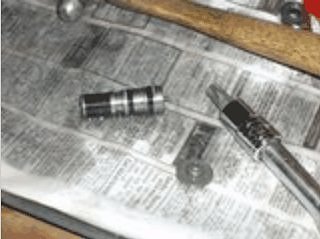
Installing pump spool valve:
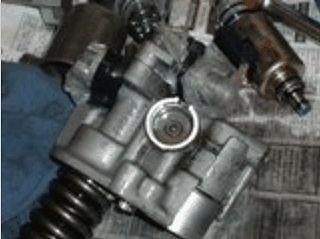
Bleeding step 1: Fill pump cavity and install pump motor & drive. Fluid will squirt from port indicated by arrow:
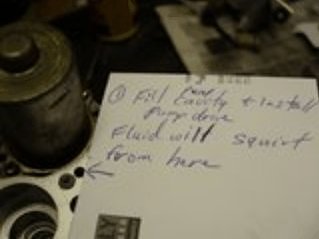
Bleeding step 2: Install pump drive cap screws (T27 Torx bit)
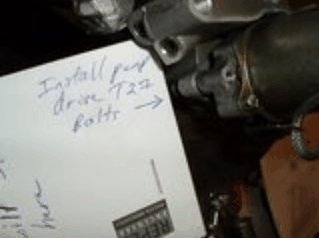
Bleeding step 3: Fill expander piston/ BU piston cavity indicated by right hand arrow. Fluid will run into and fill solenoid valve cavity.
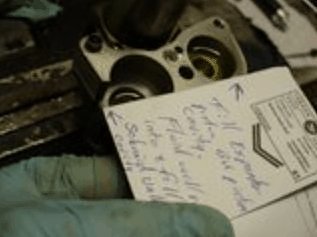
Bleeding step 4: Install solenoid valve. Note that fluid will squirt from port indicated by arrow. Note that fluid will squirt out of reservoir cavity.
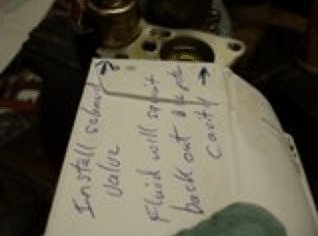
Bleeding step 5: Install back-up piston.
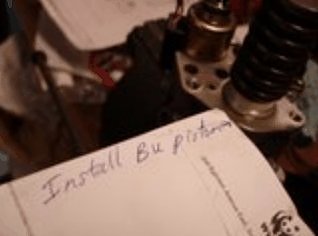
Bleeding step 6: Fluid squirts from the two ports indicated by arrows:
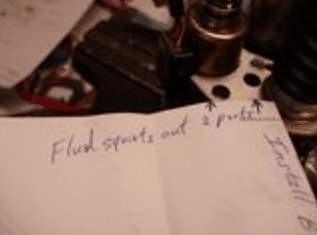
Bleeding step 7: Install check valve gallery plug and spring:
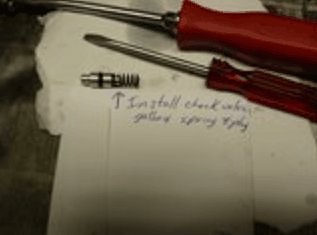
Bleeding step 8: Installing check valve gallery plug & spring:
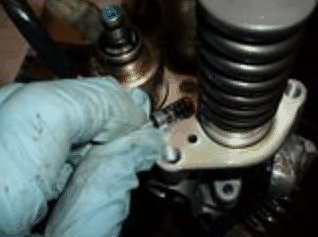
Bleeding step 9:Remove reservoir cap & bellows:
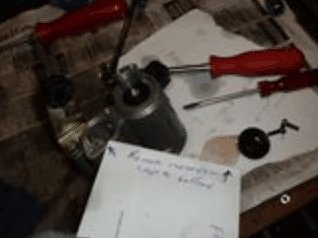
Bleeding step 10: Install back-up piston housing:
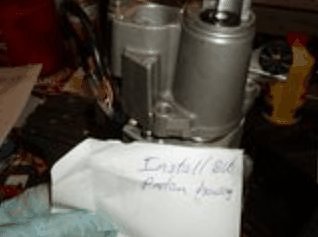
Bleeding step 11: Press back-up piston inward firmly until seated:
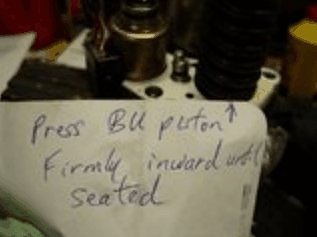
Bleeding step 12: Clean brake fluid from glasses & erase sound track from camera:
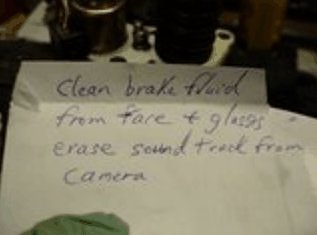
Bleeding step 13: Reinstall gallery plug indicated by arrow. Swearing optional. (VBG)
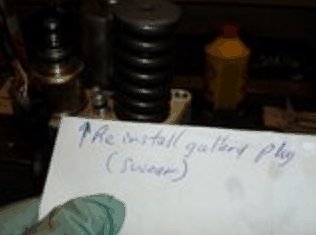
Bleeding step 14: Install back-up piston housing again:
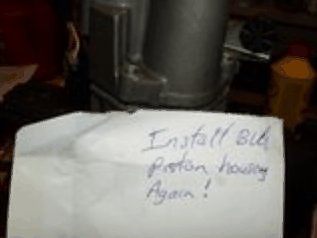
Bleeding step 15: Install pump spool valve spring plate, coil springs, cover and retaining ring:
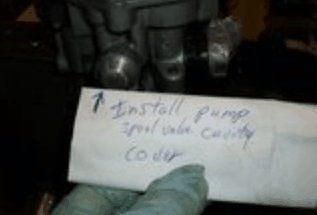
Bleeding step 16: Fill reservoir
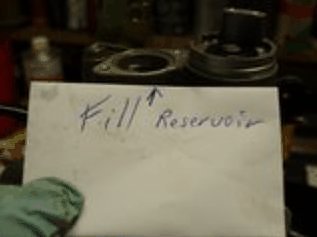
Bleeding step 17: Pump limit switch bellows to move air bubbles out of back-up piston cavity:
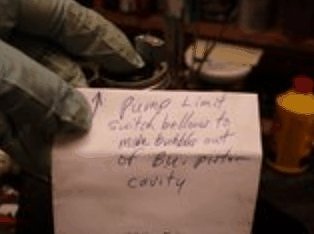
Bleeding step 18: Run pump to purge system:
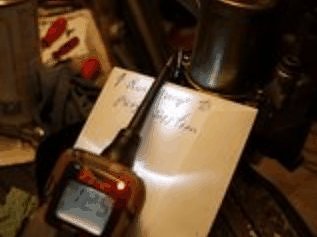
Bleeding step 19: Clean glasses again!
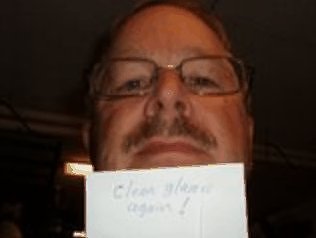
Bleeding step 20: Use cover lid & shop towel to retain spray:
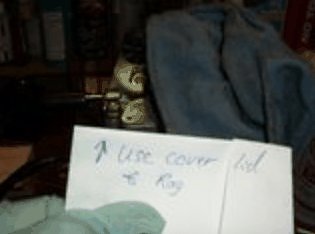
Bleeding step 21: Run pump again and note that limit switch stud is extended.
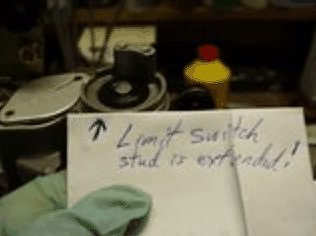
Bleeding step 22: Power solenoids to circulate fluids.
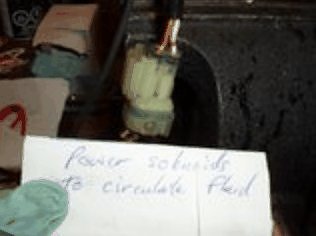
Bleeding step 23: Clean glasses again!

Bleeding step 24: Connect ohmmeter to limit switch terminals:
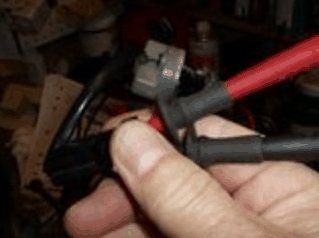
Bleeding step 25: Cycle pump to ensure that limit switch closes (zero ohms) when pump runs.
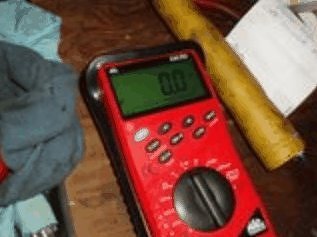
Bleeding step 26: Cycle solenoid valves & ensure that limit switch opens (over limit on ohmmete
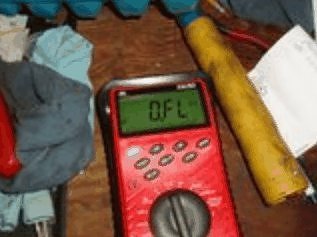
Bleeding step 27: Retest limit switch several times and adjust if required. Open when stud is low & closed when stud is high.
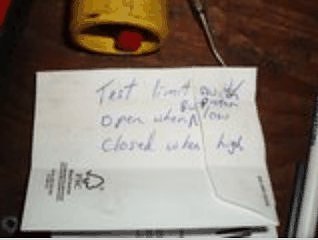
Wash it down and you're done.
Hope this is useful, I could post the rest of the 185 photos taken on this project. (VBG)
~~~
Thank You for your contribution, Norm Keller, STOC #8030.
#89
ST1100 Archive of Wisdom / Re: ABS 1 - Modulator Assembly...
Last post by KoTAOW - February 17, 2012, 09:35:27 PMABS 1 - Modulator Assembly Tutorial ( ST1100 ) - Part #6
Comments by Norm Keller, STOC #8030:
Here is a the pump spool with plunger in place as first removed from the modulator:
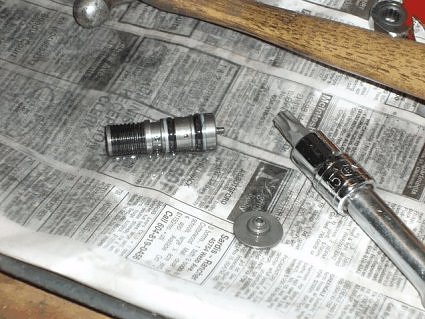
Notice the coil spring in the spool is in full compression.
Here is a photo of the disassembled pump spool with pump plunger and coil spring:
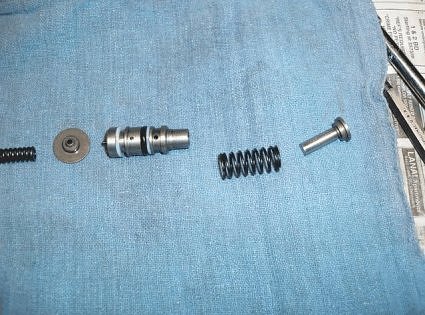
The spring to the left is one of the springs which seats the pump plunger to the ready position.
Here is the pump spool with piston free to move in its normal stroke and as it should appear:
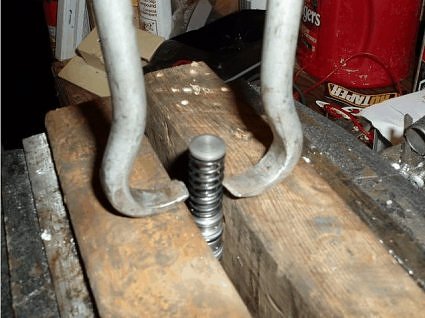
The coil spring is extended. The jaws are for an injector puller which I used to pull the plunger.
In order to remove the pump spool, it must be pushed from the pump drive end and outward through the pump bore. The pump motor and drive must be removed:
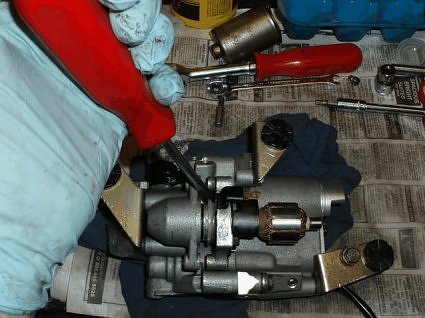
Here is a the pump bore cap being held in compression by a bench vise to allow the wire snap ring to be removed.
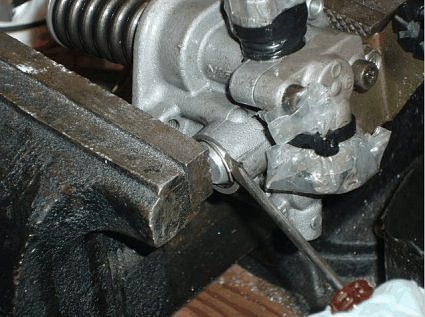
Cap and springs being removed:
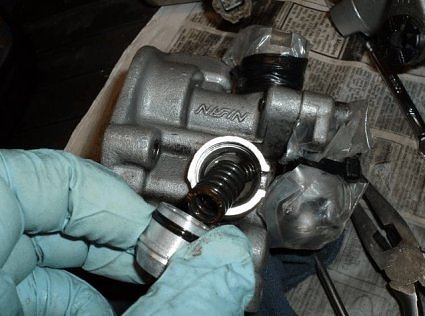
Removing Spring Seat:
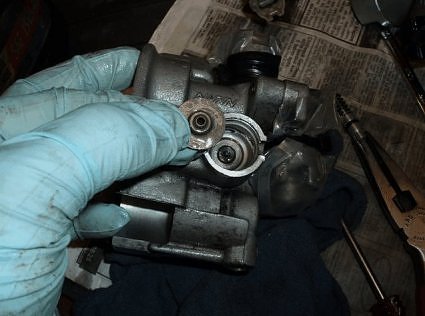
In this view the end of the pump plunger can be seen in the side of the pump bore:
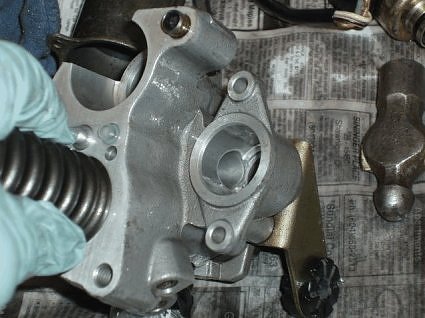
Care must be taken to force the pump spool inward until it can be removed from the bore.
Following removal of the pump spool and freeing up of the spool, it will be necessary to remove corrosion from the spool bore and pump piston. The piston is easy because the surfaces are external so some crocus cloth and elbow grease will do nicely. Honing the internal bore of the pump spool is another matter which will require a small Cratex wheel, tiny hole hone, or lots of time and a rolled up piece of crocus cloth. No idea how long that might take but it is certainly do-able against the $1800.00 for a new one.
Thanks to Mike Fisher for the opportunity and thanks to those who also contributed to this thread.
~~~
Thank You for your contribution, Norm Keller, STOC #8030.
#90
ST1100 Archive of Wisdom / Re: ABS 1 - Modulator Assembly...
Last post by KoTAOW - February 17, 2012, 09:34:57 PMABS 1 - Modulator Assembly Tutorial ( ST1100 ) - Part #5
Comments by Norm Keller, STOC #8030:
In an effort to improve general ABS knowledge I will attempt to add individual observations as they occur to me and as energy allows.
Here is a side view of the ABS module with the white plastic limit switch cover and limit switch removed:
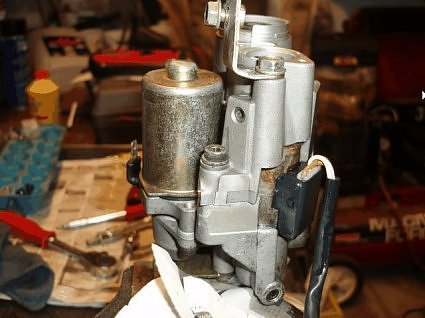
Note the ABS pump motor housing on the left. The spade lug electrical connector leading from the motor can be seen to the extreme left.
The motor (field) housing can be removed without removing the armature and pump drive assembly. This can be useful for hand turning the pump to check operation.
A problem in removing the motor field housing is that the flanges on the housing interlock with the reservoir housing. In order to allow the housing flanges to clear, remove the pump Torx screws (T27 drive bit) and pry the drive outward a short distance which will allow the pump motor to be angled to the side sufficiently to allow the field housing to clear the reservoir housing.
This technique will allow the motor internals, brushes, etc. to be inspected without opening the hydraulic portion of the modulator.
Note: I recommend adding a couple of drops of motor oil to the Oilite pump motor bushings to replace the lubricant lost to evaporation over the years.
The electrical connector and harness on the right side are the three leads which connect to the solenoid valve assembly. The solenoid valve assembly is the steel cadmium plated (slightly gold colored) cylinder immediately behind the black rubber connector boot.
The solenoid valves are not separate as shown in the diagrams but rather are included, back to back, in the solenoid valve assembly.
The mounting bracket which extends upward from the top of the photo is to the left of the reservoir/back-up spring housing. The reservoir cavity can be seen in front, immediately behind the hex bolt securing the mounting bracket.
Note the two threaded holes on the ends of the flange surface which secure the reservoir bellows and reservoir cap.
Behind the reservoir and higher, is the top of the back-up spring cavity where the limit switch bellows can be seen as a black donut with aluminium centre.
The limit switch stud (plate or what-ever) in the centre of the bellows is pushed outwards by the end of the back-up piston in order to close the limit switch to signal the ECU to shut down or start the pump motor.
The movement or not of the bellows stud serves as an indicator of the back-up piston positon when diagnosing the modulator operation. The bellows can also be "pumped" to move air bubbles from the spring housing into the reservoir during refill & bleeding.
The mounting platform for the limit switch is out of sight behind the mounting bracket but the limit switch cap's retaining groove can be seen around the end of the limit switch area.
During assembly and bleeding, the modulator is mounted in the orientation shown and fluid poured into the reservoir which will flow into the spring cavity with some help by pumping the limit switch diaphragm.
Fluid will also drain downward and drain out of the pump spool valve cavity unless the spool valve cap is in place.
It took some experimentation to derive the correct order for bleeding.
When operating the pump without cycling the inlet or outlet valves, the pump will fill the back-up piston cavity, compressing the spring and extending the limit switch stud.
Cycling the outlet valve will vent the back-up piston volume into the reservoir and mainly around into the spring cavity as the spring forces the back-up piston to battery.
When viewing the open, three-wire plug from the solenoid valve harness, the common connection for the two solenoids is the "corner" one which connects to the white/orange wire. Or at least the colours so appear to my aged eyes.
~~~
Of course it wasn't until the modulator was packed for shipment that I remembered the other thing....
Mike's modulator is a front one so I wanted to compare it to a rear one to see how difficult it might be to substitute one for the other.
I'm not prepared to pull STella's modulator.....hmmm, that might be mis-understood in some company. So will have to settle for comparing with the modulator in place.
The top mounting brackets are different in shape but the bracket could easily be transfered from one to another. Fabricating a top bracket for either configuration would be easily done by anyone with access to a bench vise and basic tools. Top bracket = not an issue.
Lower brackets, ditto, move or make. Lower bracket = no problem.
Upper hose banjo mounting (to caliper) appears to be in an identical location on both modulators. Upper hose connection = no problem.
Lower hose mounting (from master cylinder) is part of the bolt-on lower section which means that these two parts can be exchanged between front & rear modulators.
Solution #2 for master cylinder hose would be to substitute another hose such as the front master cylinder hose, front caliper hose or match a hose from another source. Not a big problem.
Solution #3 to correct the orientation of the master cylinder hose connector ......no option but to pull the one from Mike's and....YES!!!!!!
It fits in the opposite direction!!!! The lower housing is simply assembled at 180 degree orientation, same part.
Lower hose = no problem
Pump electrical connector = same.
Pump ground connection (earth) goes to the same bolt = no problem.
Solenoid valve wire connector: Here there's a problem. The harness plug which connects between the modulator and the bike's wiring harness is different from front to rear units.
Solutions:
1) Cut wires and splice to harness. Do-able.
2) Disconnect pins from the old unit's plug and swap plug bodies= Do-able.
3) Simply unplug the harness from the solenoid pack and plug in the harness from the old unit = doable.
4) If both harnesses are not available (unlikely) then I could fabricate a plug from some terminals, heat shrink and epoxy/silicone. Do-able.
Conclusion: The front & rear modulators can be substituted with less effort than the remove & re-install.
On with the project. I have some photos of the units side-by-side but they really aren't of much value because they are pictures of twins. If anyone wants to see them. post & I'll stick them up here.
~~~
Parts which can be removed without opening the fluid cavities to air are:
1) The white plastic limit switch cap.
2) The limit switch itself.
3) The pump motor's field housing. The two Phillips screws secure the housing which is a permanent magnet unit. The two T27 bolts which mount the pump drive assembly into the modulator housing must be backed off and the drive assembly pried back sufficiently to cock the motor and drive to the side, away from the modulator housing. The motor field housing (the steel cadmium plated/gold colored) has a pair of flanges which catch onto the modulator housing unless the pump drive is backed out to allow the pump motor to clear.
See the motor at left in this photo:
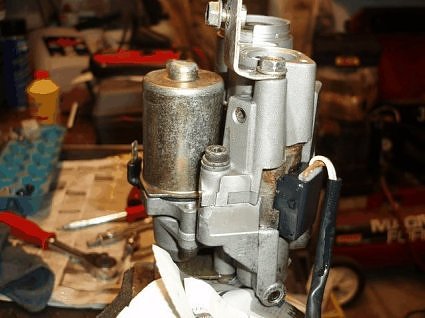
The motor drive can be seen as the aluminum saddle with one bolt partially engaged. It is necessary to pry the pump drive upward enough to allow it to cock to the side but not enough to pass the "O" ring seal or air may enter the modulator. This is not a difficult task because there is a fair amount of engagement. The solenoid pack's harness plug to which I will refer later is on the right side. The solenoid valve pack can be partially seen as gold colored.
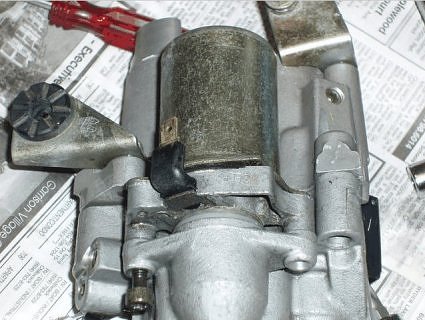
4) The harness which plugs directly into the solenoid valve pack and leads to the bike's harness plug. This is the harness which differs from front to rear modulators.
The flat connector plug (white) can be seen plugged into the black insulator of the solenoid. It can be seen that the solenoid valves face in opposite directions.
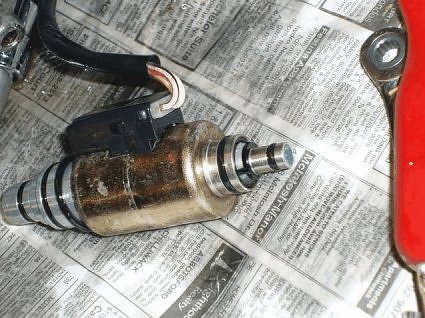
5) The mounting brackets can be swapped between the two modulators without opening the fluid cavities.
~~~
I forgot to respond to the question regarding a seized pump. In discussing this issue with Mike Fisher, it seems most likely that a failure due to contamination of the brake fluid within the modulator will result in a seizure of the pump piston within the pump spool valve.
The diagrams in the manuals do not represent the pump components in a meaningful way as they do not resemble in size, shape, or location, the real components. I mention this to avoid someone being confused by trying to use the diagrams as a guide for understanding the operation of the modulator.
The pump is a mushroom shaped steel piston which strokes in the steel body of the spool valve. The piston is returned to battery (the outward end of the stroke) by the small coil spring which is located around the piston and tensions between the head of the "mushroom" piston and the body of the spool valve. The piston is forced inward in its stroke by the action of the eccentric single row ball bearing mounted to the pump drive shaft.
Any significant increase in friction affecting movement of the piston will likely exceed the ability of the pump piston's coil spring to return the piston to battery. In this event the pump will cease operation. The pump has a positive means of moving the piston inward which is the pumping action which forces the fluid under high pressure.
A seizure which prevented the piston from moving inward in the stroke would either stall the pump motor or break something. This eventuality is prevented by two effects:
1) Long before the friction reached a critical level for the pumping stroke, the effort of returning the piston would be beyond the ability of the spring to return the piston for another stroke.
2) The pump's spool valve is located toward the pump drive by the pair of concentric coil springs between the spool valve and the pump cover cap. In the event that pressure or seizure should become too high for these two springs to resist, the spool valve shifts away from the pump motor's drive shaft to reduce the pumping effect.
There is no external means of applying force to the pump piston.
The diagrams suggest that the pump is a rotary type by virtue of the circular pump symbol but this is simply mis-understanding based on a simple diagram.
While working on the modulator, I became convinced that a fluid change every few years should see these units lasting forever. I cannot see that these operate for sufficient time for motor or mechanical wear of the internals to be a factor.
If the modulator could be filled with a hydraulic fluid, automatic transmission fluid or some other, non-hygroscoptic medium, it should endure indefinitely. Seal compatibility would be the concern as even should the modulator seals be compatible, any tiny exchange of oil into the brake system, proper, would swell and destroy master cylinder cups and likely caliper seals. Not an option.
The modulator must come apart in order to change the fluid. As I explained in an earlier post, almost all of the fluid can be changed by removal of the housing end which contains the back-up piston spring and reservoir.
From this point, the reservoir and back-up piston cavity can be refilled. A more complete refill will be achieved by prying the pump drive upward which will allow that cavity to be dumped out and refilled as mentioned in Bleeding Step #1. I do note that the open pump drive cavity was not shown so here is a better view of the open cavities.
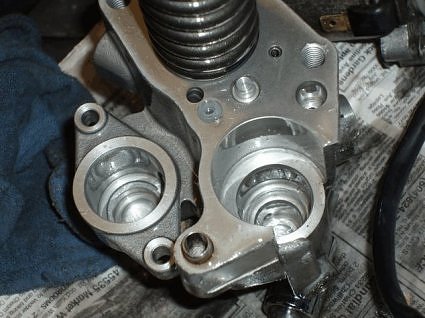
Note the pump drive cavity on the left. The pump drive mounting holes can be seen across the cavity. The locating dowel which seizes into the aluminum of the other housing is seen in the lower center of the photo. Mike is correct about the effort required to move this puppy as it was still tough when I removed the housing for the second time. Care is required so as to avoid damage.
The solenoid valve cavity is located to the lower right side and is readily opened by gently prying the solenoid valve pack upward. Having removed the pump drive and solenoid valve, the fluid can be poured from these two cavities. They can then be refilled as per the bleeding instructions.
Removal of the pump spool valve assembly, coil springs, spring plate and cap is a much more involved process which might best be avoided if the pump is functioning normally. There is little to be accomplished because the pump piston and pump bore require specialized tooling to re-surface. The check valve can be extracted but these valves are very easily, make that extremely! easily damaged. Given that no parts are available, risk must be avoided.
The "O" rings can be sourced from local supply but other parts will be more difficult. If someone can donate a "dead" modulator, I will be able to do more research without the concern of keeping a bike off the road.
~~~
I think the only part not referenced is the ABS pump motor. As can be seen from the photo:

The field housing can be removed as outlined earlier in this thread but it may be worth mention that the brushes can be replaced.
In order to remove the brushes the armature must be removed from the pump drive. The snap ring must be removed from the end of the drive and the bearings, eccentric drive and motor drive housing must be separated from the armature.
The brushes can be removed from the brush holder, by removing the two brush holder screws and sliding the brush holder upward. Brushes can be matched from alternator or electric motor brushes available from auto supply or electric motor repair shops respectively. Brushes which are too large in cross section or length can be reduced by draw filing or grinding.
~~~
Thank You for your contribution, Norm Keller, STOC #8030.
